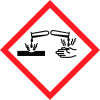CLP-CCV-01-5
AccuStandard, Inc
Revision date : 2015-08-06


Note: Ingredients listed on restricted chemical lists
EC/CAS
19049-40-2
Name of the chemical
Hexakis[.mu.-(acetato-O:O')]-.mu.4-oxotetraberyllium
Concentration
N/A
EC/CAS
7789-09-5
Name of the chemical
Ammonium dichromate
Concentration
N/A
EC/CAS
7440-02-0
Name of the chemical
Nickel
Concentration
N/A
EC/CAS
1314-62-1
Name of the chemical
Vanadium pentoxide (orthorhombic crystalline form)
Concentration
N/A
EC/CAS
7732-18-5
Name of the chemical
Water, distilled, conductivity or of similar purity H2O
Concentration
N/A
General Information
Revision date
2015-08-06
Product name
CLP-CCV-01-5
Supplier name
AccuStandard, Inc
Emergency telephone
AccuStandard, Inc
Icons in SDS
Company Information
Company name
AccuStandard, Inc
E-mail address of the competent person responsible for the Safety Data Sheet
edocs@accustandard.com
GHS Information
Signal word
Danger
Hazard Codes
Hazard statements (CLP)
H314, H318, H320, H371
Hazard statements
Code
Statements
H314
Causes severe skin burns and eye damage
H318
Causes serious eye damage
H320
Causes eye irritation
H371
May cause damage to organs
Precautionary statements
Code
Statements
P260
Do not breathe dust/fume/gas/mist/vapors/spray.
P262
Do not get in eyes, on skin, or on clothing.
P264
Wash ... thoroughly after handling.
P310
Immediately call a POISON CENTER or doctor/physician.
P338
Remove contact lenses, if present and easy to do. Continue rinsing.
P352
Wash with plenty of water/...
P380
Evacuate area.
P404
Store in a closed container.
Section 2
SECTION 2: Hazards identification
2.2 Label elements
0 2 HEALTH 2 0 FLAMMABILITY - continued P338 - Eye contact: Immediately flush with plenty of water. After initial flushing, remove and contact lenses and continue flushing for at least 15 minutes. Assure adequate flushing by separating the eyelids with fingers. P352 - Skin contact: Wash thoroughly with soap and water. Get medical attention if irritation develops or persists. P380 - Evacuate the area of all non-essential personnel. Wear a self-contained breathing apparatus and appropriate personal protection. Eliminate any ignition sources until the area is determined to be free from explosion or fire hazards. Contain the release and eliminate its source, if this can be done without risk. Take up and containerize for proper disposal. Comply with Federal, State, and local regulations. P404 - Store in a tightly closed container.
Signal word
Danger 0
Hazard statements
H314 - Causes severe skin irritation. (Category 1B) H318 - Causes serious eye damage. (Eye damage/irritation, category 1) H320 - Irritating to eyes. (Eye damage/irritation, category 2B) H371 - May cause lung damage. (Specific target organ toxicity - single exposure, inhalation) Category 2 Precautionary Codes: P260 - Do not breathe vapor. P262 - Do not get in eyes, on skin or clothing. P264 - Wash thoroughly after handling. Do not take internally. Eye wash and safety equipment should be readily available. P310 - Ingestion: Call a physician or poison control center immediately. If conscious, give water freely. - continued
2.3 Other hazards
2.2.1 - Symptom of Exposure Health/Environment To the best of our knowledge the chemical, physical and toxicological properties of the component ingredients have not been thoroughly investigated, however, exposure to any chemical should be kept to a minimum. May cause lung damage. (Specific target organ toxicity - single exposure, inhalation) Category 2
Potential health effects
Causes serious eye damage. (Eye damage/irritation, category 1) Causes severe skin irritation. (Category 1B) Irritating to eyes. (Eye damage/irritation, category 2B) Irritating to mucous membrane and upper respiratory system. May be harmful if swallowed. (Acute toxicity, oral, category 5) 2.2.3 - Routes of Entry Inhalation, ingestion or skin contact. 2.2.4 - Carcinogenicity Contains one or more components that are classified (ACGIH, IARC, NTP, OSHA) as a suspected cancer hazard in quantities less than 0.1%.

